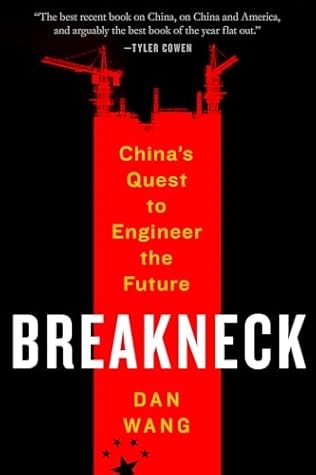More on this book
Community
Kindle Notes & Highlights
by
Dan Wang
Read between
September 23 - October 13, 2025
The Chinese state builds gleaming public works and doesn’t flinch from locking up ethnic minorities or locking down whole cities. Too many outsiders see only the enrichment or the repression. Living there puts you face to face with both a sustained rise in living standards and the authoritarian pulses emanating out of Beijing. It became no contradiction for me to appreciate that things are getting better and getting worse. I saw how China is made up of both strong entrepreneurs and a strong government, with a state that both moves fast and breaks things and moves fast and breaks people.
The starkest contrast between the two countries is the competition that will define the twenty-first century: an American elite, made up of mostly lawyers, excelling at obstruction, versus a Chinese technocratic class, made up of mostly engineers, that excels at construction. That’s the big idea behind this book. It’s time for a new lens to understand the two superpowers: China is an engineering state, building big at breakneck speed, in contrast to the United States’ lawyerly society, blocking everything it can, good and bad.
Looking at these two countries, I came to realize the inadequacy of twentieth-century labels like capitalist, socialist, or, worst of all, neoliberal. They are no longer up to the task of helping us understand the world, if they ever were. Capitalist America intrudes upon the free market with a dense program of regulation and taxation while providing substantial (albeit imperfect) redistributive policies. Socialist China detains union organizers, levies light taxes, and provides a threadbare social safety net. The greatest trick that the Communist Party ever pulled off is masquerading as
...more
What do engineers like to do? Build. Since ancient times, the emperors have tried to tame the mighty rivers that sweep away not only farmland, but also imperial reigns. In modern times, new public works—roads, bridges, tunnels, dams, power plants, entire new cities—are the engineering state’s solution to any number of quandaries. Since 1980, after Deng’s reforms began, China has built an expanse of highways equal to twice the length of the US systems, a high-speed rail network twenty times more extensive than Japan’s, and almost as much solar and wind power capacity as the rest of the world
...more
Engineers go hard in one direction, and if they perceive something isn’t working, they switch with no loss of speed toward another. They don’t suffer criticism from humanist softies. Change in China can be so dramatic because so few voices are part of the political process. To a first approximation, the twenty-four men who make up the Political Bureau (the highest echelon of the Communist Party, usually shortened to Politburo) are the only people permitted to do politics. Once they’ve settled questions of strategy, the only remaining task is for the bureaucracy to sort out the details. But
...more
Above all, China built housing. Its urban population has grown by an average of sixteen million people each year since 1978, which means, in effect, that the state built a new city the size of greater New York City and greater Boston combined every year for thirty-five years. Though Beijing, Shanghai, and Shenzhen have soaring housing prices, high rates of construction plus rising wages have broadly improved affordability. From 2007 to 2018, the average price of an urban apartment fell from nine times the average household income to seven times. This building spree consumes colossal amounts of
...more
Overall, China’s manufacturing workforce employs more than a hundred million people, around eight times that of the United States. That is a big stock of people who are fueling the creation of new process knowledge. A focus on manufacturing gives China another advantage in technological competition with the United States. It can simply wait for American scientists to do the fundamental research before Chinese companies take over the production.
To succeed, the United States doesn’t need to adopt China’s means of construction. This book has detailed how the engineering state’s approach has wrought horrors and is no longer fit for purpose even in China. Rather, the United States can look toward other Western countries, like Spain, Germany, and Japan, which strike a better balance between public consultation and environmental review on the one hand and getting stuff built on the other. To achieve all of this, I propose—very gently—to unwind the dominance of lawyers in the United States. That will require us to confront the proceduralism
...more


